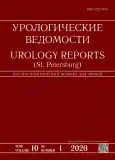Патоморфология адаптационных изменений в оставшейся почке в раннем послеоперационном периоде после нефрэктомии
- Авторы: Шорманов И.С.1, Лось М.С.2, Косенко М.В.1, Шорманова Н.С.1
-
Учреждения:
- Федеральное государственное образовательное учреждение высшего образования «Ярославский государственный медицинский университет» Министерства здравоохранения Российской Федерации
- Государственное бюджетное учреждение здравоохранения Ярославской области «Областная клиническая больница»
- Выпуск: Том 10, № 1 (2020)
- Страницы: 19-24
- Раздел: Оригинальные статьи
- URL: https://journals.rcsi.science/uroved/article/view/13378
- DOI: https://doi.org/10.17816/uroved10119-24
- ID: 13378
Цитировать
Аннотация
Цель исследования. Изучение адаптационных возможностей единственной оставшейся почки в раннем послеоперационном периоде после нефрэктомии в эксперименте.
Материалы и методы. В эксперименте участвовало 35 лабораторных белых крыс, которые были разделены на три экспериментальные группы. Группа 1 (n = 5) — интактные животные; группа 2 (n = 15) — крысы, которым выполняли нефрэктомию слева; группа 3 (n = 15) — крысы, которым выполняли нефрэктомию слева и дополнительно создавали 90-минутную гипоксическую гипоксию. Забор гистологического материала производили на 5, 21 и 60-е сутки после операции.
Результаты. Характерными морфологическими изменениями в единственной оставшейся почке были увеличение размеров клубочков и уменьшение их количества. Выявлен фиброз нефронов, сопровождающийся повышенной выработкой антигенов эпителием канальцев, которая, вероятно, является ответом на каскадное усиление окислительного стресса и повышенное высвобождение цитокинов, стимулирующих выработку интраренального коллагена.
Выводы. Нефрэктомия и гипоксия — провокаторы развития системного дистресс-синдрома, в результате которого формируется «порочный патогенетический круг», снижающий функциональные возможности почечной ткани. Это может рассматриваться как один из ранних доклинических механизмов инициации заболеваний единственной почки в будущем.
Ключевые слова
Полный текст
Открыть статью на сайте журналаОб авторах
Игорь Сергеевич Шорманов
Федеральное государственное образовательное учреждение высшего образования «Ярославский государственный медицинский университет» Министерства здравоохранения Российской Федерации
Email: i-s-shormanov@yandex.ru
SPIN-код: 7772-8420
Scopus Author ID: 6507085029
д-р мед. наук, профессор, заведующий кафедрой урологии с нефрологией
Россия, ЯрославльМарина Сергеевна Лось
Государственное бюджетное учреждение здравоохранения Ярославской области «Областная клиническая больница»
Автор, ответственный за переписку.
Email: 922099@mail.ru
канд. мед. наук, врач-уролог
Россия, ЯрославльМаксим Вадимович Косенко
Федеральное государственное образовательное учреждение высшего образования «Ярославский государственный медицинский университет» Министерства здравоохранения Российской Федерации
Email: Maxim.kosenko76@yandex.ru
старший преподаватель кафедры физической культуры и спорта
Россия, ЯрославльНаталия Сергеевна Шорманова
Федеральное государственное образовательное учреждение высшего образования «Ярославский государственный медицинский университет» Министерства здравоохранения Российской Федерации
Email: i-s-shormanov@rambler.ru
ассистент кафедры патологической анатомии
Россия, ЯрославльСписок литературы
- Иванов А.П., Тюзиков И.А. Нефрэктомия в современных условиях: причины и дальнейшая судьба больных с единственной почкой // Фундаментальные исследования. – 2011. – № 7. – С. 64–66. [Ivanov AP, Tyuzikov IA. Nefr·ektomiya v sovremennykh usloviyakh: prichiny i dal’neyshaya sud’ba bol’nykh s edinstvennoy pochkoy. Fundamental research. 2011;(7):64-66. (In Russ.)]
- Тюзиков И.А., Греков Е.А., Мартов А.Г. Заболевания единственной почки: научная история и эволюция проблемы // Урология. – 2013. – № 6. – С: 103–110. [Tyuzikov IA, Grekov EA, Martov AG Diseases of solitary kidney: the history and evolution of scientific issues. Urologiia. 2013;(6):103-110. (In Russ.)]
- Rabkin R, Fervenza FC. Renal Hypertrophy and Kidney Disease in Diabetes. Diab Metab Rev. 1996;12(3):217-241. https://doi.org/10.1002/(SICI)1099-0895(199610)12:3<217::AID-DMR165>3.0.CO;2-C.
- Schlichter A, Wunderlich H, Junker K, et al. Where are the limits of elective nephron-sparing surgery in renal cell carcinoma? Eur Urol. 2000;37(5):517-520. https://doi.org/10.1159/000020187.
- Ghoneim TP, Sjoberg DD, Lowrance W, et al. Partial nephrectomy for renal tumors in solitary kidneys: postoperative renal function dynamics. World J Urol. 2015;33(12):2023-2029. https://doi.org/10.1007/s00345-015-1581-9.
- Sharma N, Zhang Z, Mir MC, et al. Comparison of 2 computed tomography-based methods to estimate preoperative and postoperative renal parenchymal volume and correlation with functional changes after partial nephrectomy. Urology. 2015;86(1):80-86. https://doi.org/10.1016/j.urology.2015.04.029.
- Takagi T, Mir MC, Campbell RA, et al. Assessment of outcomes in partial nephrectomy incorporating detailed functional analysis. Urology. 2014;84(5):1128-1133. https://doi.org/10.1016/j.urology.2014.07.008.
- Zargar H, Autorino R, Kaouk JH. Nephron-sparing surgery for tumors in a solitary kidney. Curr Opin Urol. 2014;24(5):459-465. https://doi.org/10.1097/MOU.0000000000000082.
- Zargar H, Bhayani S, Allaf ME, et al. Comparison of perioperative outcomes of robot-assisted partial nephrectomy and open partial nephrectomy in patients with a solitary kidney. J Endourol. 2014;28(10):1224-1230. https://doi.org/10.1089/end.2014.0297.
- Salevitz DA, Patton MW, Tyson MD, et al. The impact of ischemia on long-term renal function after partial nephrectomy in the two kidney model. J Endourol. 2015;29(4):474-478. https://doi.org/10.1089/end.2014.0476.
- Иванов А.П., Тюзиков И.А. Влияние заболеваний единственной почки на ее функциональное состояние в отдаленном периоде после нефрэктомии // Российский медицинский журнал. – 2012. – № 1. – С. 24–26. [Ivanov AP, Tyuzikov IA. Impact of diseases of a solitary kidney on its functional status in the late period of nephrectomy. Russian medical journal. 2012;(1):24-26. (In Russ.)]
- Иванов А.П., Тюзиков И.А., Фатеев Д.М. Современная этиологическая структура заболеваний единственной почки после нефрэктомии // Военно-медицинский журнал. – 2011. – Т. 332. – № 9. – С. 69–71. [Ivanov AP, Tyuzikov IA, Fateev DM. The modern etiological structure of single kidney diseases after nephrectomy. Military medical journal. 2011;332(9):69-71. (In Russ.)]
- Шорманов И.С., Лось М.С., Косенко М.В. Расстройства адаптации, вызванные нефрэктомией // Урологические ведомости. – 2019. – Т. 9. – № 2. – С. 23–28. [Shormanov IS, Los MS, Kosenko MV. Adaptation disorders caused by nephrectomy. Urologicheskie vedomosti. 2019;9(2):23-28. (In Russ.)]. https://doi.org/10.17816/uroved9223-28.
Дополнительные файлы













